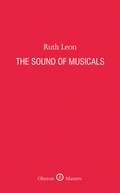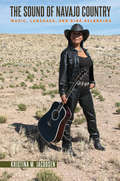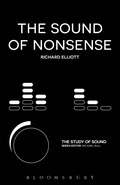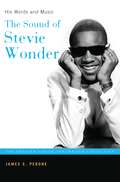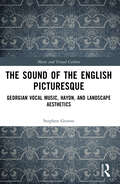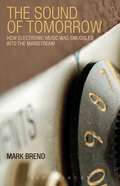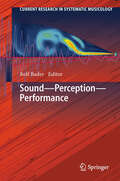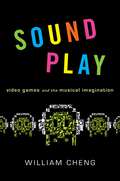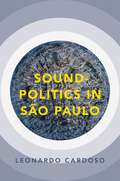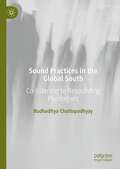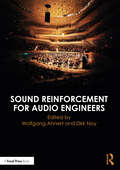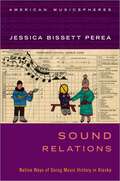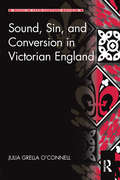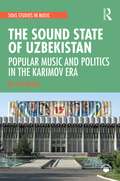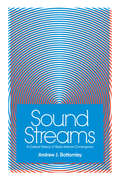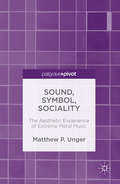- Table View
- List View
The Sound of Musicals (Oberon Masters Series)
by Ruth LeonThe world of musicals is beautiful, complex, hilarious, hard-headed, and improbable. It is as hard to make a great musical as it is to fly a spaceship to the moon and there are at least as many moving parts. Why is a great musical as significant a theatrical achievement as, say, King Lear?In this entertaining new title in Oberon Masters Series, Ruth Leon tells all about the composers, the lyricists, the directors and the pioneers of the stage musical on both sides of the Atlantic while trying to reveal the truth behind the eternal question - what are musicals and why do we love them?‘A whirlwind tour through musical theatre history... This book may be small but, like all the great shows about which Leon writes, it is perfectly formed’ - Jewish Chronicle‘A slim and succinct account of the handful of 20th century musicals which, in Leon’s very well informed and experienced opinion, have changed the genre forever... I learned a great deal. Buy it.’ – The Stage‘Light-hearted but informative… with an air of authority… is also beautifully bound: a slim, smart, slightly old-fashioned looking hardback.’ - What’s on stage.com ‘Ruth Leon has the ability to capture the essence of each musical, which is the real strength of pocket-sized hardback… a lovely little volume that will delight any devotee of this genre’ - British Theatre Guide‘A must for any performing arts or drama student.’ - Ink Pellet
The Sound of Navajo Country: Music, Language, and Diné Belonging (Critical Indigeneities)
by Kristina M. JacobsenIn this ethnography of Navajo (Diné) popular music culture, Kristina M. Jacobsen examines questions of Indigenous identity and performance by focusing on the surprising and vibrant Navajo country music scene. Through multiple first-person accounts, Jacobsen illuminates country music’s connections to the Indigenous politics of language and belonging, examining through the lens of music both the politics of difference and many internal distinctions Diné make among themselves and their fellow Navajo citizens. As the second largest tribe in the United States, the Navajo have often been portrayed as a singular and monolithic entity. Using her experience as a singer, lap steel player, and Navajo language learner, Jacobsen challenges this notion, showing the ways Navajos distinguish themselves from one another through musical taste, linguistic abilities, geographic location, physical appearance, degree of Navajo or Indian blood, and class affiliations. By linking cultural anthropology to ethnomusicology, linguistic anthropology, and critical Indigenous studies, Jacobsen shows how Navajo poetics and politics offer important insights into the politics of Indigeneity in Native North America, highlighting the complex ways that identities are negotiated in multiple, often contradictory, spheres.
The Sound of Nonsense (The Study of Sound)
by Richard ElliottIn The Sound of Nonsense, Richard Elliott highlights the importance of sound in understanding the 'nonsense' of writers such as Lewis Carroll, Edward Lear, James Joyce and Mervyn Peake, before connecting this noisy writing to works which engage more directly with sound, including sound poetry, experimental music and pop. By emphasising sonic factors, Elliott makes new and fascinating connections between a wide range of artistic examples to ultimately build a case for the importance of sound in creating, maintaining and disrupting meaning.
The Sound of Nonsense (The Study of Sound)
by Richard ElliottIn The Sound of Nonsense, Richard Elliott highlights the importance of sound in understanding the 'nonsense' of writers such as Lewis Carroll, Edward Lear, James Joyce and Mervyn Peake, before connecting this noisy writing to works which engage more directly with sound, including sound poetry, experimental music and pop. By emphasising sonic factors, Elliott makes new and fascinating connections between a wide range of artistic examples to ultimately build a case for the importance of sound in creating, maintaining and disrupting meaning.
The Sound of Stevie Wonder: His Words and Music (The Praeger Singer-Songwriter Collection)
by James E. PeroneSince his professional debut in 1962, Stevie Wonder has recorded sixty-four singles that have made the Billboard top 100, including ten that reached number one. Wonder was one of the first Motown artists to have complete control over the writing, arranging, and recording of his songs, and achieved that stature before he was 20 years old. He has won 17 Grammy awards, was elected to the Rock and Roll Hall of Fame in 1989, and earned the Grammy's Lifetime Achievement Award in 1996. Equally important, his work as a producer, arranger, and instrumentalist on other artists' recordings has put him in the highest rank of musical collaborators. This is the first work of criticism on this important documentarian of American life, as well as the introductory volume in The Praeger Singer-Songwriter Collection. Through a combination of biography and critical analysis, James Perone's groundbreaking new book reveals the many ways in which Stevie Wonder's body of work emerged, developed, reflected its time, and influenced myriad other artists.After revealing the social, cultural, and political context of Wonder's work, the book provides detailed analysis of his compositions and recordings, with a focus on both his well-known songs and those known only to his hardcore fans. The volume also contains discussions of cover versions of Wonder's compositions, a discography of his recordings, a song title index, an annotated bibliography, and a general index.
The Sound of the English Picturesque: Georgian Vocal Music, Haydn, and Landscape Aesthetics (Music and Visual Culture)
by Stephen GrovesRevealing the connections between the veneration of national landscape and eighteenth- century English vocal music, this study restores English music’s relationship with the picturesque. In the eighteenth century, the emerging taste for the picturesque was central to British aesthetics, as poets and painters gained popularity by glorifying the local landscape in works concurrent with the emergence of native countryside tourism. Yet English music was seldom discussed as a medium for conveying national scenic beauty. Stephen Groves explores this gap, and shows how secular song, the glee, and national theatre music expressed a uniquely English engagement with landscape. Using an interdisciplinary approach, Groves addresses the apparent ‘silence’ of the English picturesque. The book draws on analysis of the visualisations present in the texts of English vocal music, and their musical treatment, to demonstrate how local composers incorporated celebrations of landscape into their works. The final chapter shows that the English picturesque was a crucial influence on Joseph Haydn’s oratorio The Seasons. Suitable for anyone with an interest in eighteenth- century music, aesthetics, and the natural environment, this book will appeal to a wide range of specialists and non- specialists alike.
The Sound of the English Picturesque: Georgian Vocal Music, Haydn, and Landscape Aesthetics (Music and Visual Culture)
by Stephen GrovesRevealing the connections between the veneration of national landscape and eighteenth- century English vocal music, this study restores English music’s relationship with the picturesque. In the eighteenth century, the emerging taste for the picturesque was central to British aesthetics, as poets and painters gained popularity by glorifying the local landscape in works concurrent with the emergence of native countryside tourism. Yet English music was seldom discussed as a medium for conveying national scenic beauty. Stephen Groves explores this gap, and shows how secular song, the glee, and national theatre music expressed a uniquely English engagement with landscape. Using an interdisciplinary approach, Groves addresses the apparent ‘silence’ of the English picturesque. The book draws on analysis of the visualisations present in the texts of English vocal music, and their musical treatment, to demonstrate how local composers incorporated celebrations of landscape into their works. The final chapter shows that the English picturesque was a crucial influence on Joseph Haydn’s oratorio The Seasons. Suitable for anyone with an interest in eighteenth- century music, aesthetics, and the natural environment, this book will appeal to a wide range of specialists and non- specialists alike.
The Sound of Tomorrow: How Electronic Music Was Smuggled into the Mainstream
by Mark BrendLondon, 1966: Paul McCartney met a group of three electronic musicians called Unit Delta Plus. McCartney was there because he had become fascinated by electronic music, and wanted to know how it was made. He was one of the first rock musicians to grasp its potential, but even he was notably late to the party. For years, composers and technicians had been making electronic music for film and TV. Hitchcock had commissioned a theremin soundtrack for Spellbound (1945); The Forbidden Planet (1956) featured an entirely electronic score; Delia Derbyshire had created the Dr Who theme in 1963; and by the early 1960s, all you had to do was watch commercial TV for a few hours to hear the weird and wonderful sounds of the new world. The Sound of Tomorrow tells the compelling story of the sonic adventurers who first introduced electronic music to the masses. A network of composers, producers, technicians and inventors, they took emerging technology and with it made sound and music that was bracingly new.
The Sound of Tomorrow: How Electronic Music Was Smuggled into the Mainstream
by Mark BrendLondon, 1966: Paul McCartney met a group of three electronic musicians called Unit Delta Plus. McCartney was there because he had become fascinated by electronic music, and wanted to know how it was made. He was one of the first rock musicians to grasp its potential, but even he was notably late to the party. For years, composers and technicians had been making electronic music for film and TV. Hitchcock had commissioned a theremin soundtrack for Spellbound (1945); The Forbidden Planet (1956) featured an entirely electronic score; Delia Derbyshire had created the Dr Who theme in 1963; and by the early 1960s, all you had to do was watch commercial TV for a few hours to hear the weird and wonderful sounds of the new world. The Sound of Tomorrow tells the compelling story of the sonic adventurers who first introduced electronic music to the masses. A network of composers, producers, technicians and inventors, they took emerging technology and with it made sound and music that was bracingly new.
Sound - Perception - Performance (Current Research in Systematic Musicology #1)
by Rolf BaderMusical Performance covers many aspects like Musical Acoustics, Music Psychology, or motor and prosodic actions. It deals with basic concepts of the origin or music and its evolution, ranges over neurocognitive foundations, and covers computational, technological, or simulation solutions. This volume gives an overview about current research in the foundation of musical performance studies on all these levels. Recent concepts of synchronized systems, evolutionary concepts, basic understanding of performance as Gestalt patterns, theories of chill as performance goals or historical aspects are covered. The neurocognitive basis of motor action in terms of music, musical syntax, as well as therapeutic aspects are discussed. State-of-the-art applications in performance realizations, like virtual room acoustics, virtual musicians, new concepts of real-time physical modeling using complex performance data as input or sensor and gesture studies with soft- and hardware solutions are presented. So although the field is still much larger, this volume presents current trends in terms of understanding, implementing, and perceiving performance.
Sound Play: Video Games and the Musical Imagination (Oxford Music / Media)
by William ChengVideo games open portals to fantastical worlds where imaginative play and enchantment prevail. These virtual settings afford us considerable freedom to act out with relative impunity. Or do they? Sound Play explores the aesthetic, ethical, and sociopolitical stakes of people's creative engagements with gaming's audio phenomena-from sonorous violence to synthesized operas, from democratic music-making to vocal sexual harassment. William Cheng shows how video games empower their designers, composers, players, critics, and scholars to tinker (often transgressively) with practices and discourses of music, noise, speech, and silence. Faced with collisions between utopian and alarmist stereotypes of video games, Sound Play synthesizes insights across musicology, sociology, anthropology, communications, literary theory, philosophy, and additional disciplines. With case studies spanning Final Fantasy VI, Silent Hill, Fallout 3, The Lord of the Rings Online, and Team Fortress 2, this book insists that what we do in there-in the safe, sound spaces of games-can ultimately teach us a great deal about who we are and what we value (musically, culturally, humanly) out here. Foreword by Richard Leppert Video Games Live cover image printed with permission from Tommy Tallarico
Sound Play: Video Games and the Musical Imagination (Oxford Music / Media)
by William ChengVideo games open portals to fantastical worlds where imaginative play and enchantment prevail. These virtual settings afford us considerable freedom to act out with relative impunity. Or do they? Sound Play explores the aesthetic, ethical, and sociopolitical stakes of people's creative engagements with gaming's audio phenomena-from sonorous violence to synthesized operas, from democratic music-making to vocal sexual harassment. William Cheng shows how video games empower their designers, composers, players, critics, and scholars to tinker (often transgressively) with practices and discourses of music, noise, speech, and silence. Faced with collisions between utopian and alarmist stereotypes of video games, Sound Play synthesizes insights across musicology, sociology, anthropology, communications, literary theory, philosophy, and additional disciplines. With case studies spanning Final Fantasy VI, Silent Hill, Fallout 3, The Lord of the Rings Online, and Team Fortress 2, this book insists that what we do in there-in the safe, sound spaces of games-can ultimately teach us a great deal about who we are and what we value (musically, culturally, humanly) out here. Foreword by Richard Leppert Video Games Live cover image printed with permission from Tommy Tallarico
Sound-Politics in São Paulo (Currents in Latin American and Iberian Music)
by Leonardo CardosoHow does the state separate music from noise? How can such a filtering apparatus shape the content and form of sound production in the city? As a marker of co-presence to the hearing body, sound is always open to (or rather opens up) the politics of shared existence. In the throes of the post-dictatorship period, Brazil's legislative and executive branches implemented a series of sweeping measures to address quality of life concerns, including environmental pollution and urban inequality. In São Paulo, noise control became a recurrent controversy, growing in size and scale between the 1990s and 2010s. Together with the much-debated fear of crime and the socioeconomic and cultural tensions between the rich urban center and the poor peripheries, such ecological agendas against noise as a harmful pollutant have reconfigured the presence of environmental sounds in the city. In this book, Cardoso argues that the framing of specific sounds as unavoidable, unnecessary, or as harmful "noise" has been an effective strategy to organize spaces and administer group behavior in this rapidly expanding city. He focuses on two interrelated processes. First, the series of institutional regulatory mechanisms that turn sounds into the all-embracing "noise" susceptible to state intervention. Second, the constant attempts of interested groups in either attaching or detaching specific sounds (musical events, industrial noise, traffic noise, religious sounds, etc.) from regulatory scrutiny. Sound-politics is the dynamic that emerges from both processes - the channels through which sounds enter (and leave) the sphere of state regulation.
SOUND-POLITICS IN SAO PAULO CILAM C (Currents in Latin American and Iberian Music)
by Leonardo CardosoHow does the state separate music from noise? How can such a filtering apparatus shape the content and form of sound production in the city? As a marker of co-presence to the hearing body, sound is always open to (or rather opens up) the politics of shared existence. In the throes of the post-dictatorship period, Brazil's legislative and executive branches implemented a series of sweeping measures to address quality of life concerns, including environmental pollution and urban inequality. In São Paulo, noise control became a recurrent controversy, growing in size and scale between the 1990s and 2010s. Together with the much-debated fear of crime and the socioeconomic and cultural tensions between the rich urban center and the poor peripheries, such ecological agendas against noise as a harmful pollutant have reconfigured the presence of environmental sounds in the city. In this book, Cardoso argues that the framing of specific sounds as unavoidable, unnecessary, or as harmful "noise" has been an effective strategy to organize spaces and administer group behavior in this rapidly expanding city. He focuses on two interrelated processes. First, the series of institutional regulatory mechanisms that turn sounds into the all-embracing "noise" susceptible to state intervention. Second, the constant attempts of interested groups in either attaching or detaching specific sounds (musical events, industrial noise, traffic noise, religious sounds, etc.) from regulatory scrutiny. Sound-politics is the dynamic that emerges from both processes - the channels through which sounds enter (and leave) the sphere of state regulation.
Sound Practices in the Global South: Co-listening to Resounding Plurilogues
by Budhaditya ChattopadhyayThis book develops a comprehensive understanding of the unique sound worlds of key regions in the Global South, through an auto-ethnographic method of self-reflective conversations with prominent sound practitioners from South Asia, Africa, the Middle East and Latin America. The conversations navigate various trajectories of sound practices, illuminating intricate sonic processes of listening, thinking through sounds, ideating, exposing, and performing with sound. This collection of conversations constitutes the main body of the book, including critical and scholarly commentaries on aural cultures, sound theory and production. The book builds a ground-up approach to nurturing knowledge about aural cultures and sonic aesthetics, moving beyond the Eurocentric focus of contemporary sound studies. Instead of understanding sound practices through consumption and entertainment, they are explored as complex cultural and aesthetic systems, working directly with the practitioners themselves, who largely contribute to the development of the sonic methodologies. Refocusing on the working methods of practitioners, the book reveals a tension between the West’s predominant colonial-consumerist cultures, and the collective desires of practitioners to resist colonial models of listening by expressing themselves in terms of their arts and craft, and their critical faculties.Conversations with: Clarence Barlow, Sandeep Bhagwati, Rajesh K. Mehta, Sharif Sehnaoui, Ximena Alarcón Díaz, Hardi Kurda, Mario de Vega, Luka Mukhavele, Khyam Allami, Cedrik Fermont, Khaled Kaddal, David Velez, Juan Duarte, Youmna Saba, Abdellah M. Hassak, Mariana Marcassa, Amanda Gutiérrez, Syma Tariq, Alma Laprida, Siamak Anvari, Mohamad Safa, Debashis Sinha, Zouheir Atbane, Constanza Bizraelli, Jatin Vidyarthi, Joseph Kamaru, Surabhi Saraf, Isuru Kumarasinghe, Hemant Sreekumar.
Sound Reinforcement for Audio Engineers
by Wolfgang AhnertSound Reinforcement for Audio Engineers illustrates the current state of the art in sound reinforcement. Beginning with an outline of various fields of applications, from sports venues to religious venues, corporate environments and cinemas, this book is split into 11 chapters covering room acoustics, loudspeakers, microphones and acoustic modelling among many other topics. This comprehensive book packed with references and a historical overview of sound reinforcement design is an essential reference book for students of acoustics and electrical engineering, but also for engineers looking to expand their knowledge of designing sound reinforcement systems.
Sound Reinforcement for Audio Engineers
by Wolfgang Ahnert Dirk NoySound Reinforcement for Audio Engineers illustrates the current state of the art in sound reinforcement. Beginning with an outline of various fields of applications, from sports venues to religious venues, corporate environments and cinemas, this book is split into 11 chapters covering room acoustics, loudspeakers, microphones and acoustic modelling among many other topics. This comprehensive book packed with references and a historical overview of sound reinforcement design is an essential reference book for students of acoustics and electrical engineering, but also for engineers looking to expand their knowledge of designing sound reinforcement systems.
Sound Relations: Native Ways of Doing Music History in Alaska (American Musicspheres)
by Jessica Bissett PereaSound Relations delves into histories of Inuit musical life in Alaska to register the significance of sound as integral to self-determination and sovereignty. Offering radical and relational ways of listening to Inuit performances across a range of genres--from hip hop to Christian hymnody and traditional drumsongs to funk and R&B --author Jessica Bissett Perea registers how a density (not difference) of Indigenous ways of musicking from a vast archive of presence sounds out entanglements between structures of Indigeneity and colonialism. This work dismantles stereotypical understandings of "Eskimos," "Indians," and "Natives" by addressing the following questions: What exactly is "Native" about Native music? What does it mean to sound (or not sound) Native? Who decides? And how can in-depth analyses of Native music that center Indigeneity reframe larger debates of race, power, and representation in twenty-first century American music historiography? Instead of proposing singular truths or facts, this book invites readers to consider the existence of multiple simultaneous truths, a density of truths, all of which are culturally constructed, performed, and in some cases politicized and policed. Native ways of doing music history engage processes of sound worlding that envision otherwise, beyond nation-state notions of containment and glorifications of Alaska as solely an extraction site for U.S. settler capitalism, and instead amplifies possibilities for more just and equitable futures.
Sound Relations: Native Ways of Doing Music History in Alaska (American Musicspheres)
by Jessica Bissett PereaSound Relations delves into histories of Inuit musical life in Alaska to register the significance of sound as integral to self-determination and sovereignty. Offering radical and relational ways of listening to Inuit performances across a range of genres--from hip hop to Christian hymnody and traditional drumsongs to funk and R&B --author Jessica Bissett Perea registers how a density (not difference) of Indigenous ways of musicking from a vast archive of presence sounds out entanglements between structures of Indigeneity and colonialism. This work dismantles stereotypical understandings of "Eskimos," "Indians," and "Natives" by addressing the following questions: What exactly is "Native" about Native music? What does it mean to sound (or not sound) Native? Who decides? And how can in-depth analyses of Native music that center Indigeneity reframe larger debates of race, power, and representation in twenty-first century American music historiography? Instead of proposing singular truths or facts, this book invites readers to consider the existence of multiple simultaneous truths, a density of truths, all of which are culturally constructed, performed, and in some cases politicized and policed. Native ways of doing music history engage processes of sound worlding that envision otherwise, beyond nation-state notions of containment and glorifications of Alaska as solely an extraction site for U.S. settler capitalism, and instead amplifies possibilities for more just and equitable futures.
Sound, Sin, and Conversion in Victorian England (Music in Nineteenth-Century Britain)
by Julia Grella O'ConnellThe plight of the fallen woman is one of the salient themes of nineteenth-century art and literature; indeed, the ubiquity of the trope galvanized the Victorian conscience and acted as a spur to social reform. In some notable examples, Julia Grella O’Connell argues, the iconography of the Victorian fallen woman was associated with music, reviving an ancient tradition conflating the practice of music with sin and the abandonment of music with holiness. The prominence of music symbolism in the socially-committed, quasi-religious paintings of the Pre-Raphaelites and their circle, and in the Catholic-Wagnerian novels of George Moore, gives evidence of the survival of a pictorial language linking music with sin and conversion, and shows, even more remarkably, that this language translated fairly easily into the cultural lexicon of Victorian Britain. Drawing upon music iconography, art history, patristic theology, and sensory theory, Grella O’Connell investigates female fallenness and its implications against the backdrop of the social and religious turbulence of the mid-nineteenth century.
Sound, Sin, and Conversion in Victorian England (Music in Nineteenth-Century Britain)
by Julia Grella O'ConnellThe plight of the fallen woman is one of the salient themes of nineteenth-century art and literature; indeed, the ubiquity of the trope galvanized the Victorian conscience and acted as a spur to social reform. In some notable examples, Julia Grella O’Connell argues, the iconography of the Victorian fallen woman was associated with music, reviving an ancient tradition conflating the practice of music with sin and the abandonment of music with holiness. The prominence of music symbolism in the socially-committed, quasi-religious paintings of the Pre-Raphaelites and their circle, and in the Catholic-Wagnerian novels of George Moore, gives evidence of the survival of a pictorial language linking music with sin and conversion, and shows, even more remarkably, that this language translated fairly easily into the cultural lexicon of Victorian Britain. Drawing upon music iconography, art history, patristic theology, and sensory theory, Grella O’Connell investigates female fallenness and its implications against the backdrop of the social and religious turbulence of the mid-nineteenth century.
The Sound State of Uzbekistan: Popular Music and Politics in the Karimov Era (SOAS Studies in Music Series)
by Kerstin KlenkeThe Sound State of Uzbekistan: Popular Music and Politics in the Karimov Era is a pioneering study of the intersection between popular music and state politics in Central Asia. Based on 20 months of fieldwork and archival research in Tashkent, this book explores a remarkable era in Uzbekistan’s politics (2001–2016), when the Uzbek government promoted a rather unlikely candidate to the prominent position of state sound: estrada, a genre of popular music and a musical relic of socialism. The political importance it attached to estrada was matched by the establishment of an elaborate bureaucratic apparatus for state oversight. The Sound State of Uzbekistan shows the continuing legacy of Soviet concepts to frame the nexus between music, artists and the state, and explains the extraordinary potency ascribed to estrada. At the same time, it challenges classical readings of transition and also questions common binary models for researching culture in totalitarian or authoritarian states. Proposing to approach lives in music under authoritarianism as a form of normality instead, the author promotes a post-Cold War paradigm in music studies.
The Sound State of Uzbekistan: Popular Music and Politics in the Karimov Era (SOAS Studies in Music Series)
by Kerstin KlenkeThe Sound State of Uzbekistan: Popular Music and Politics in the Karimov Era is a pioneering study of the intersection between popular music and state politics in Central Asia. Based on 20 months of fieldwork and archival research in Tashkent, this book explores a remarkable era in Uzbekistan’s politics (2001–2016), when the Uzbek government promoted a rather unlikely candidate to the prominent position of state sound: estrada, a genre of popular music and a musical relic of socialism. The political importance it attached to estrada was matched by the establishment of an elaborate bureaucratic apparatus for state oversight. The Sound State of Uzbekistan shows the continuing legacy of Soviet concepts to frame the nexus between music, artists and the state, and explains the extraordinary potency ascribed to estrada. At the same time, it challenges classical readings of transition and also questions common binary models for researching culture in totalitarian or authoritarian states. Proposing to approach lives in music under authoritarianism as a form of normality instead, the author promotes a post-Cold War paradigm in music studies.
Sound Streams: A Cultural History of Radio-Internet Convergence
by Andrew J BottomleyIn talking about contemporary media, we often use a language of newness, applying words like “revolution” and “disruption.” Yet, the emergence of new sound media technologies and content—from the earliest internet radio broadcasts to the development of algorithmic music services and the origins of podcasting—are not a disruption, but a continuation of the century-long history of radio. Today’s most innovative media makers are reintroducing forms of audio storytelling from radio’s past. Sound Streams is the first book to historicize radio-internet convergence from the early ’90s through the present, demonstrating how so-called new media represent an evolutionary shift that is nevertheless historically consistent with earlier modes of broadcasting. Various iterations of internet radio, from streaming audio to podcasting, are all new radio practices rather than each being a separate new medium: radio is any sound media that is purposefully crafted to be heard by an audience. Rather than a particular set of technologies or textual conventions, web-based broadcasting combines unique practices and features and ideas from radio history. In addition, there exists a distinctive conversationality and reflexivity to radio talk, including a propensity for personal stories and emotional disclosure, that suits networked digital media culture. What media convergence has done is extend and intensify radio’s logics of connectivity and sharing; sonically mediated personal expression intended for public consideration abounds in online media networks. Sound Streams marks a significant contribution to digital media and internet studies. Its mix of cultural history, industry research, and genre and formal analysis, especially of contemporary audio storytelling, will appeal to media scholars, radio and podcast practitioners, audio journalism students, and dedicated podcast fans.
Sound, Symbol, Sociality: The Aesthetic Experience of Extreme Metal Music
by Matthew UngerBased on ethnographic research within the extreme metal community, Unger offers a thought-provoking look at how symbols of authenticity and defilement fashion social experience in surprising ways. Exploring the many themes and ciphers that comprise this musical community, this book interprets aesthetic resonances as a way to understand contemporary identity, politics, and social relations. In the end, this book develops a unique argument: the internal composition of the community’s music and sound moulds symbols that shape, reflect, and constrain social patterns of identity, difference, and transgression. This book contributes to the sociology of sound and music, the study of religion in popular culture, and the role of aesthetics in everyday life. It will be of interest to upper level students, post-graduate students and scholars of religion, popular culture, and philosophy.
